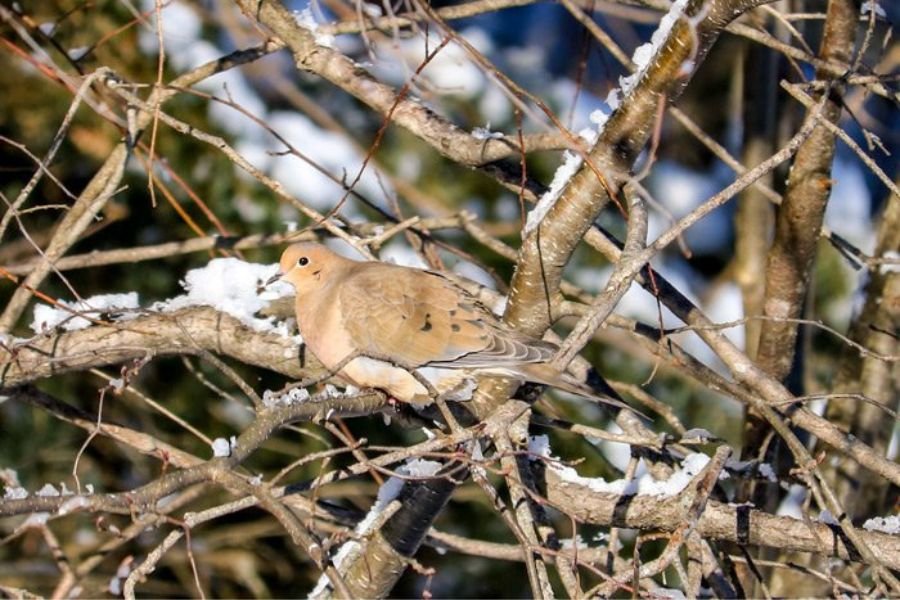
Doves are gentle and graceful birds that are often seen as symbols of peace and love. In Massachusetts, three species of doves can be found: the Mourning Dove, the Rock Pigeon, and the White-winged Dove.
In this blog post, we will learn more about these three types of doves, including their physical characteristics, habitat, diet, and conservation status. We will also provide tips on how to attract doves to your backyard.
In Massachusetts, three species of doves can be found: the Mourning Dove, the Rock Pigeon, and the White-winged Dove.
Mourning Dove in Massachusetts

The mourning dove is the most common dove species in Massachusetts. These types of doves are also most common in North America. You can easily find these types of doves in Michigan.
Mourning doves are the Medium-sized doves. They can grow up to 11-13 inches long with slender bodies.
The Mourning Dove (Zenaida macroura) is a widespread dove species found throughout California.
They have long tails, pointed wings, gray-brown plumage, and dark wing spots. Also, they have white outer tail feathers, small black bills, and red feet.
- Behavior: They are very social and often seen in flocks. They are also known for their gentle nature and soothing cooing songs.
- Diet: They are Primarily herbivores, they eat seeds, fruits, berries, and occasionally insects and small animals.
- Habitat: Found in forests, woodlands, fields, and urban areas, preferring areas with abundant food and water.
- Nesting: Build nests in trees and shrubs using twigs and leaves. Lay two eggs, incubated by both parents for about 14 days. Mourning Doves also make nests in Arizona’s open habitats.
- Conservation Status: Common and not at risk of extinction, but faces threats like habitat loss, hunting, and disease.
How to Help Mourning Doves
- Plant Native Plants: Grow native plants in your yard or garden to provide food and shelter for doves.
- Use Bird Feeders: Set up bird feeders with seeds and berries to attract doves.
- Provide Water: Offer a water source like a birdbath or shallow dish for doves to drink and bathe.
- Avoid Chemicals: Refrain from using pesticides, herbicides, and harmful chemicals that can harm doves and their habitats.
- Report Injured Doves: If you come across sick or injured doves, contact a wildlife rehabilitator for assistance.”
Rock Pigeons in Massachusetts

Rock pigeons are also known as common pigeons. Rock pigeons are the most common dove species in Massachusetts. They are also common types of doves in Louisiana.
Rock pigeons, also called common pigeons, are widespread and well-known birds in Massachusetts.
They adapt to various habitats, from urban to rural areas. They are social birds that often form flocks and are admired for their intelligence and adaptability.
Physical Description:
- Medium-sized birds, about 12-14 inches long.
- Stout build with a short tail and broad wings.
- The plumage is typically blue-gray with darker bars on the wings and a white rump.
- Red beak and feet.
Diet: Rock pigeons are omnivores, eating a diverse diet that includes seeds, fruits, insects, and small animals. They often forage on the ground or at bird feeders.
Habitat: Found in various environments, including cities, towns, and rural areas. They thrive where there’s ample food and water. Rock pigeons often nest in human-made structures.
Nesting: Nests are constructed in buildings, bridges, and other man-made locations. They use twigs, leaves, and debris to build their nests. Rock pigeons lay two eggs, which both the male and female incubate for about 18 days.
Conservation Status: Rock pigeons are abundant and not at risk of extinction. However, they face threats like habitat loss, hunting, and disease.
White-winged Doves in Massachusetts

White-winged doves, known for their beauty and grace, are found in the southern and southeastern regions of Massachusetts. They are slightly smaller than mourning doves, with a 20-inch wingspan.
White-winged doves have light brown plumage with a white rump and distinctive white wing markings. They also possess a black bill and red feet.
Habitat and Diet: White-winged doves prefer wooded areas, streambanks, riversides, parks, and gardens. They are omnivores, consuming seeds, fruits, insects, and small animals.
Nesting: These doves construct their nests in trees and shrubs using twigs and leaves. They typically lay two eggs, with both male and female birds incubating them for about 14 days.
Conservation Status: White-winged doves are a common and abundant species, not currently at risk of extinction. However, they face threats such as habitat loss, hunting, and disease.
Conclusion
Three types of doves can be found in Massachusetts: the mourning dove, the rock pigeon, and the white-winged dove. All three species are beautiful and fascinating birds that play an important role in the ecosystem. Mourning doves are the most common type of dove in Massachusetts. They can be found in a variety of habitats, including forests, woodlands, fields, and urban areas. Rock pigeons are also common in Massachusetts, and can be seen in flocks in cities and towns. White-winged doves are less common in Massachusetts but can be found in the southern and southeastern regions of the state.
If you want to attract doves to your yard, there are a few things you can do. Plant native plants that produce seeds and berries, put out a bird feeder with seeds and berries and provide a source of water, such as a birdbath or shallow dish. Avoid using pesticides and other chemicals that can harm doves.


